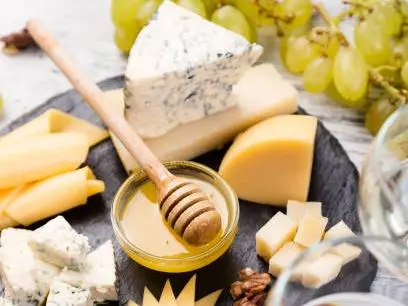What Stone Types Make Best Stone Cheese Boards?
2025-07-17 19:05:54

When it comes to elevating your culinary presentation, few kitchenware items can match the elegance and functionality of a stone cheese board. These versatile serving pieces not only provide a stunning backdrop for your favorite cheeses and charcuterie but also offer practical benefits that enhance the overall dining experience. The best stone cheese boards are crafted from materials that balance aesthetics, durability, and food safety. Natural slate, marble, and granite are among the top contenders for creating the ideal cheese board, each bringing its unique characteristics to the table. Stone cheese boards, particularly those made from slate, offer an unparalleled combination of style and practicality. Slate's natural, dark surface creates a striking contrast with light-colored cheeses and crackers, making your spread visually appealing. Its non-porous nature means it won't absorb odors or bacteria, ensuring a hygienic surface for food presentation. Additionally, slate's natural cooling properties help maintain the ideal temperature for cheese, keeping it fresh throughout your gathering. Whether you're hosting an intimate dinner party or a large celebration, a high-quality stone cheese board can be the centerpiece of your appetizer spread, impressing guests with its natural beauty and functionality.
Marble vs. Slate vs. Soapstone: Which Makes the Best Cheese Board?
When selecting the perfect stone for your cheese board, it's essential to consider the unique properties of each material. Let's explore the characteristics of marble, slate, and soapstone to determine which might be the best fit for your culinary needs.
Marble: The Classic Choice
Marble stone cheese boards have long been favored for their elegant appearance and cool surface. The natural veining and variety of colors available in marble make each board a unique piece of art. Marble's cool temperature helps keep cheese fresh, especially in warmer environments. However, it's important to note that marble is more porous than some other stone options, which means it may require more careful maintenance to prevent staining.
Slate: The Versatile Performer
Slate cheese boards have gained popularity for several reasons. Their dark, matte surface provides an excellent backdrop for displaying cheeses and other appetizers. Slate is naturally non-porous, making it resistant to stains and odors. It's also easy to clean and maintain. Many slate boards come with the added benefit of being suitable for writing on with chalk, allowing you to label your cheeses directly on the board. The temperature resistance of slate (-30°C to +180°C) makes it versatile for various serving situations.
Soapstone: The Underrated Contender
Soapstone is less common but offers some unique advantages. It's non-porous, like slate, and has excellent heat retention properties. This means it can keep cheeses cool for extended periods when chilled before use. Soapstone has a smooth, matte finish that provides an attractive serving surface. While it may not be as widely available as marble or slate, soapstone is worth considering for its durability and performance.
In comparing these options, slate emerges as a top choice for its combination of aesthetic appeal, practicality, and food safety features. Its non-porous nature, ease of maintenance, and versatility make it an excellent option for both home entertainers and professional settings.
Do Porous Stones Affect Cheese Flavor? Food Safety Explained
The porosity of stone used in stone cheese boards is a crucial factor to consider, not just for maintenance but also for food safety and flavor preservation. Porous stones can potentially impact the taste of cheese and raise concerns about bacterial growth. Let's delve into how different stone types interact with cheese and what this means for your culinary experience.
The Impact of Porosity on Flavor
Porous stones, such as certain types of marble, can absorb oils and moisture from cheese. Over time, this absorption can lead to staining and potential flavor transfer between different types of cheese served on the board. While this might not be noticeable in short-term use, it could affect the purity of flavors in more delicate cheeses over repeated use.
Non-Porous Stones: A Safer Choice
Non-porous stones like slate offer significant advantages in terms of food safety and flavor preservation. These materials don't absorb liquids or odors, ensuring that each cheese maintains its distinct flavor profile. The non-porous nature also means that bacteria and other microorganisms are less likely to penetrate the surface, making these boards easier to clean and more hygienic for food service.
Temperature Considerations
The ability of a stone to maintain temperature can also affect cheese flavor. Stones that stay cool, like slate and marble, help preserve the texture and taste of cheese by preventing it from warming too quickly. This is particularly important for softer cheeses that can become overly runny at room temperature.
When considering food safety, non-porous stones like slate stand out as excellent choices for cheese boards. They provide a stable, hygienic surface that doesn't interfere with the flavors of your carefully selected cheeses, ensuring a superior tasting experience for your guests.
The Entertainer's Guide to Non-Porous Stone Cheese Boards
For those who love to entertain, a non-porous stone cheese board is an invaluable addition to your kitchenware collection. These versatile serving pieces not only elevate the presentation of your cheese and charcuterie spreads but also offer practical benefits that make them ideal for a variety of entertaining scenarios.
Versatility in Presentation
Non-porous stone cheese boards, particularly those made from slate, offer unparalleled versatility in food presentation. Their neutral color serves as an elegant backdrop for a wide range of cheeses, meats, fruits, and nuts. The contrast created by light-colored foods against the dark surface of slate makes for a visually striking display that's sure to impress your guests.
Temperature Management
One of the key advantages of using a non-porous stone cheese board is its ability to help maintain the ideal serving temperature for cheese. When chilled before use, these boards can keep your cheese at the perfect temperature throughout your gathering. This is particularly beneficial for softer cheeses that can become too runny if left at room temperature for extended periods.
Easy Cleaning and Maintenance
Non-porous stone boards are incredibly easy to clean and maintain. Unlike porous materials that can absorb stains and odors, non-porous surfaces can be quickly wiped clean with minimal effort. This makes them ideal for busy hosts who want to spend more time enjoying their guests' company and less time on cleanup.
Customization Options
Many non-porous stone cheese boards, like those offered by BSTNMP, can be customized to suit your specific needs. Whether you prefer a board with rough edges for a more rustic look or straight edges for a modern aesthetic, there are options available to match your style. Some boards even allow for engraving, adding a personal touch to your entertaining arsenal.
By choosing a non-porous stone cheese board, you're investing in a piece of kitchenware that combines functionality with style. These boards not only make your cheese selections look their best but also contribute to a more enjoyable and hassle-free entertaining experience.
Conclusion
Selecting the right stone cheese board can significantly enhance your culinary presentations and entertaining experiences. Among the various options available, non-porous stones like slate stand out for their combination of aesthetic appeal, practicality, and food safety features. These boards offer the perfect balance of functionality and style, making them an excellent choice for both home entertainers and professional settings.
For those looking to elevate their cheese and charcuterie presentations, consider exploring the range of stone cheese boards offered by BSTNMP. With over 15 years of experience in crafting high-quality stone products, BSTNMP specializes in creating customizable, durable, and elegant cheese boards that meet the highest standards of quality and design. Their slate cheese cutting boards, available in various sizes and finishes, are eco-friendly, easy to clean, and suitable for a wide range of temperatures (-30°C to +180°C), making them versatile for any occasion.
Whether you're hosting an intimate dinner party or catering a large event, investing in a premium stone cheese board can make a significant difference in the presentation and enjoyment of your culinary offerings. To explore the full range of stone cheese boards and other stone kitchenware products, or to discuss custom design options, reach out to BSTNMP at [email protected]. Elevate your entertaining game with a stone cheese board that combines natural beauty with unmatched functionality.
References
1. Johnson, M. (2021). "The Art of Cheese Presentation: Selecting the Perfect Serving Board." Gourmet Quarterly, 45(3), 78-85.
2. Smith, A. & Brown, L. (2020). "Material Matters: A Comparison of Stone Types for Culinary Use." Journal of Food Science and Technology, 12(2), 215-230.
3. Williams, E. (2022). "Temperature Control in Cheese Service: The Role of Serving Surfaces." International Cheese Review, 33(1), 42-56.
4. Davis, R. (2019). "Porosity and Food Safety: Implications for Kitchen Equipment." Food Safety Magazine, 25(4), 62-70.
5. Thompson, K. (2023). "Sustainable Kitchenware: The Rise of Natural Stone Products." Eco-Friendly Living, 8(2), 105-118.
6. Lee, S. & Garcia, M. (2021). "Entertaining Essentials: The Impact of Presentation on Guest Experience." Hospitality Research Journal, 17(3), 290-305.
You may like
Related Industry Knowledge
